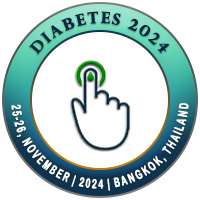_1.jpg)
Nataliia Kaspruk
Bukovinian State Medical University, UkraineTitle: The problem of drug hypersensitivity in patients with type 1 diabetes mellitus
Abstract
Recently, the increase in the number of drug allergies cases has attracted great attention. Today, up to 40 % of inpatients suffer from pathological reactions associated with drug intolerance. The most problematic, given the significant limitations of elimination measures, are allergic reactions to various types of insulin. An allergen can be not only insulin, but also protein (for example, protamine) and non-protein (for example, zinc) excipients and impurities that are included in the composition of drugs.
In the vast majority of cases, allergies are caused by insulin or its polymers, as evidenced by local allergic reactions to human insulin and systemic reactions to highly purified insulins. The literature review examines the features of true (TA) and pseudo-allergic (PA) reactions. Taking into account the fact that the clinical manifestations of TA and PA are the same, but the diagnostic capabilities are different, the approaches to their treatment also vary, which necessitates a differential diagnosis between them. The results of a retrospective analysis of medical histories, outpatient records of 170 patients with diabetes mellitus (DM) and a positive allergy history, as well as the results of an analysis of the effectiveness of antimediator drugs – quifenadine and sequifenadine – are presented. It has been established that the frequency of allergic reactions in patients with type 1 diabetes mellitus is 2.9 folds higher than in the general population, and directly depends on the duration and severity of the disease. Various types of food hypersensitivity were indicated by 37% of patients, drug hypersensitivity was observed in 34% of patients (versus 27% in the main group).
The most significant allergens for the examined patients were medications and food products. The program of preventive measures regarding the emergence of allergic diseases in patients with DM should include a nutritional education, elimination measures of possible provoking factors, adequate pharmacotherapy. Derivatives of quinuclidines demonstrate high efficiency in the treatment of allergic dermatoses in patients with diabetes, in particular with hypersensitivity to insulin medications.
Biography
Nataliia Kaspruk, Associate Professor at the Department of clinical immunology, allergology and endocrinology, Bukovinian State Medical University (Chernivtsi), has completed her PHD at the age of 35 from Bukovinian State Medical University, Ukraine. She has over 160 in scientific medical publications. Her research interestes extend to clinical immunology and allergology.

